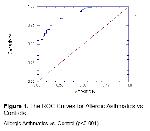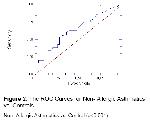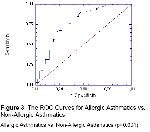 |
 |
| [ Ana Sayfa | Editörler | Danışma Kurulu | Dergi Hakkında | İçindekiler | Arşiv | Yayın Arama | Yazarlara Bilgi | E-Posta ] | |
| Fırat Üniversitesi Sağlık Bilimleri Tıp Dergisi | |||||||||||||
| 2009, Cilt 23, Sayı 2, Sayfa(lar) 091-094 | |||||||||||||
| [ Özet ] [ PDF ] [ Benzer Makaleler ] [ Yazara E-Posta ] [ Editöre E-Posta ] | |||||||||||||
| Alerjik ve Alerjik Olmayan Astım Hastaları İçin Toplam Serum IGE Seviyesi Kesim Noktaları | |||||||||||||
| Nurhan HALİSDEMİR1, Cemil ÇOLAK1, Ali KUTLU2, Sami ÖZTÜRK2 | |||||||||||||
| 1Fırat Üniversitesi, Fen Edebiyat Fakültesi, İstatistik Bölümü, Elazığ, TÜRKİYE 2Haydarpaşa GATA Eğitim Hastanesi, Alerji Kliniği, İstanbul, TÜRKİYE |
|||||||||||||
| Anahtar Kelimeler: Alerji, referans değerler, deri testi, ROC analizi, toplam IgE | |||||||||||||
| Özet | |||||||||||||
Bu çalışma, alerjik ve alerjik olmayan astım hastaları için toplam serum IgE seviyesi kesim noktalarını işlem karakteristiği eğrisi analizi ile belirlemek amacıyla yapılmaktadır. İleriye yönelik olarak tasarlanan çalışma, 149 astım hastası (99 alerjik, 50 alerjik olmayan) ve 50 kontrol bireyleri üzerinde GATA Haydarpaşa eğitim hastanesi alerji kliniğinde ocak 2005 ile aralık 2006 tarihleri arasında gerçekleştirilmiştir. Bireyler atopik alerjik hastalığı (astım) için incelendi, sonra iğne testi yöntemi kullanılarak deriden test edildi. Imx çözümleyicisi (Abbott park, IL, USA) üzerinde mikro partikül enzim bağışıklık denemesi kullanılarak belirlenen toplam IgE için serum örneği söz konusu bireylerden alındı. Toplam serum IgE seviyesi kesim noktaları, alerjik ve alerjik olmayan astım hastaları için işlem karakteristiği eğrisi analizi ile belirlenerek hesaplanmıştır. Kesim noktaları olabilirlik oran istatistiği ile tespit edilmiştir. Alerjik ve alerjik olmayan astım hastalarının ortanca toplam IgE değerleri (sırasıyla 207 (20-962) U/ml ve 40 (6.80-882) U/ml)), kontrol bireylerinin IgE değerlerinden (26 (2-220) U/ml) istatistiksel olarak önemli derecede yüksekdi (p<0.001). Alerjik ve alerjik olmayan astım hastaları için toplam serum IgE seviyesi kesim noktaları sırasıyla 220 (duyarlılık: %48.0; seçicilik: %98.0) ve 176 (duyarlılık: %20.0; seçicilik: %96.0) olarak hesaplandı. Alerjik ve alerjik olmayan astım hastalarını ayıran kesim noktası olabilirlik oran istatistiğine göre; 442 (duyarlılık: %17.0; seçicilik: %96.0) idi. Toplam IgE için duyarlılık değerleri düşük iken, seçicilik değerleri oldukça yüksek idi. Elde edilen sonuçlar, toplam serum IgE seviyesi kesim noktalarının alerjik ve alerjik olmayan astım hastalar için yardımcı olabileceğini göstermiştir. |
|||||||||||||
| Giriş | |||||||||||||
The evidence for the relationship between allergens and asthma depends on epidemiologic findings pointing out a strong association between specific immunoglobulin E (IgE), or total IgE and asthma. Asthma is almost always associated with some type of IgE-related reaction1. It was reported that there was a highly significant relationship between asthma and sensitization to different allergens (the presence of specific IgE in the serum)2. In a study related to asthma3, the relationship between asthma and total serum IgE levels was researched, and it was concluded that serum IgE level had correlation with asthma. Therefore, based on the findings of total serum IgE level may be extremely important in order to determine allergic and non-allergic asthma. The present study was designed to determine the IgE cut-off values for allergic and non-allergic asthma using the receiver operating characteristic analysis. |
|||||||||||||
| Materyal ve Metot | |||||||||||||
Patients: A prospective study was conducted on 149 asthma patients (99 allergic, 50 non-allergic) and 50 controls in GATA Haydarpasa Hospital, Department of Allergy, between January 2005 and December 2006. Skin Tests: Participants were evaluated for atopic allergic diseases (asthma) and then skin was tested using the prick test method with a lancet. A standardized panel (ALK, Denmark) including house dust mite, mold, grass, tree, weed, feather and dander mixed antigens were applied accompanied by positive (0.1% histamine phosphate) and negative (serum physiologic: phosphate-buffered physiologic saline) controls. A positive reaction was defined as a wheal with a geometric mean diameter of at least 3 mm. Resulting wheals were measured after 15 min. Prick test positivity was defined as a positive response to at least one of the allergens used. Prick tests were not performed in cases of pregnancy, dermographism and use of antihistamines. Intradermal tests including house dust mite (50Au/ml Dermatophagoides pteronyssinus and 50Au/ml Dermatophagoides farinea), mold (1/2000w/v), grass (100Bau/ml), tree (1/1000w/v), mixed antigens were performed when prick test results were negative to an aeroallergen. Antihistamines were withheld 7 days before skin testing. All subjects signed informed consent before participating. In-Vitro Tests: A serum sample drawn was analyzed for total IgE on admission. Total IgE was determined by using the microparticle enzyme immunoassay on the Imx analyzer (Abbott park, IL, USA), according to the manufacturer's instructions. Peripheral blood eosinophil counts were estimated microscopically and expressed as number of cells per microliter. Peripheral blood eosinophilia was defined as more than >200 cells/ml. Statistical Analysis: The characteristics of the patients were compared by Pearson Chi-square test, Kruskal Wallis H test and Mann Whitney U for categorical and continuous variables, respectively. IgE and age variables were not normally distributed. A two-tailed type I error level of 0.05 was considered as being statistically significant. The receiver operating characteristic (ROC) analysis was carried out to determine and calculate the cut-off points. A ROC curve shows the characteristics of a diagnostic test by graphing the false-positive rate (1-specificity) on the horizontal axis and the true-positive rate (sensitivity) on the vertical axis for various cutoff values. Cut-off point was determined by means of likelihood ratio statistic. The likelihood ratio statistic measures the value of the test for increasing certainty about a positive diagnosis. The likelihood ratio statistic is calculated as [sensitivity/(1-specifity)]4-6. Sensitivity, specificity, positive and negative predictive values for total IgE were estimated for each cut-off point. |
|||||||||||||
| Bulgular | |||||||||||||
Table 1 presents the characteristics of the patients with allergic and non-allergic asthma and controls. The median total IgE levels of allergic (207 (20-962) U/ml) and non-allergic (40 (6.80-882) U/ml) disease with asthma patients were significantly higher than the controls (26 (2-220) U/ml) (p<0.001). Age was significantly different between non-allergic asthma patients and control subjects (p<0.05). Gender was related with allergic and non-allergic asthma and controls (p=0.001).
Table 2 points out total IgE cut-off values of allergic and non-allergic asthmatics. The sensitivity values of total IgE were low, while the specificity was high.
Table 3 gives the related information for area under curve (AUC) for allergic and non-allergic asthmatics. Estimates of AUC for allergic and non-allergic asthmatics were 0.90 and 0.60, respectively and statistically significant (both, p<0.001).
Figure 1 depicts the ROC curve for allergic asthmatics versus controls. With the ROC curve, by plotting the false positives (i.e. 1-specificity) against the true positives (i.e. sensitivity), we found the optimal threshold by measuring the closest distance from the ideal point (sensitivity=1 and specificity=1, that corresponds 1- specificity=0) on the curve, by the inspection of the graph. The sensitivity of total IgE was low, while the specificity was high. Similarly, figure 2 shows ROC curve for non-allergic asthmatics vs. controls. For non-allergic asthmatics patients, the sensitivity of total IgE was lower than for allergic asthmatics patients. Figure 3 shows the ROC curves for allergic asthmatics vs. non-allergic asthmatics.
|
|||||||||||||
| Tartışma | |||||||||||||
Our results showed a large overlapping of total IgE levels in patients with allergic, non-allergic asthma and controls. The levels of median total IgE in patients with allergic and non-allergic asthma patients were significantly higher than control subjects. This results is agreement with that the level of total IgE in asthma patients is higher than that in healthy people. Consistent with our findings, Obaidi et al3 reported that median serum IgE levels in asthmatic patients were significantly higher that in the control group. There were no overlaps in the 95% mean confidence interval of lower and upper bounds in allergic asthmatic and non-asthmatic patients [252.87 (206.53-299.21), 111.95 (63.06-160.83)] versus control subjects [44.04 (29.69-58.38)]. Thus, we can coclude that discrimination may be done between the mean total IgE levels in asthmatic and non-asthmatic patients from that of controls. The median total IgE distribution in the patients with allergic and non-allergic asthma was higher than the healthy control group in both genders. Similar to previous studies, control group showed significantly higher IgE values in adult males than in adult females. This might be due to the presence of a greater prevalence of current smoking habit among male gender in Turkish population (57.8% vs. 13.5%). We found the median total IgE levels of allergic (207 U/ml) and non-allergic (40 U/ml) disease with asthma patients. In controls, the median total IgE (26 U/ml) was significantly lower than in the patients with allergic and non-allergic asthma as expected. In the same way, the median age for controls was lower than in the patients with allergic and non-allergic asthma. Based on the results of ROC analysis, the cut-off points for total IgE were 220 U/ml in allergic asthma versus control and 176 U/ml in non-allergic asthma versus control. Even though sensitivity values of total IgE were low, the specificity was high. Sensitivity, specificity and positive predictive value for allergic asthma patients were higher than for patients with non-allergic asthma. The cut-off point discriminating asthmatic patients from non-asthmatic patients was 442 U/ml based on the likelihood ratio statistic. From nonparametric area under curve analysis, AUC estimate of allergic asthma versus control was considerably high (0.90), and bigger than AUC estimate (0.65) of non-allergic asthma versus control and the estimate (0.77) of allergic asthmatic versus non-allergic asthmatic patients. This result may be owing to small sample size of non-allergic asthma patients (n=50) and control subjects (n=50) in respect of the size of allergic asthma patients (n=99). If the total IgE cutoff value of 26.20 was selected for allergic asthmatic versus non-allergic asthmatic, sensitivity and specificity were 0.96 and 0.35, respectively. However, we selected optimal cutoff value based on the likelihood ratio statistic which measures the value of the test for increasing certainty about a positive diagnosis. Several studies7,8 reported the relationship between asthma and IgE level in different places. The reported levels of total IgE change from one place to another. The findings suggest that the cutoff values for total IgE should be estimated according to different places, various sample sizes, the property of study population, the method of statistical analysis, etc. When reported studies are reviewed, ROC analysis is frequently used. Recently, Metz9 described the historical origins of ROC analysis and reviewed the importance of sampling cases appropriately, designing an observer study to avoid bias, and collecting data on a useful scale. In summary, the obtained results points out that total IgE level cut-off points may be helpful for discriminating allergic from non-allergic patients with asthma. |
|||||||||||||
| Kaynaklar | |||||||||||||
1) Sporik D, Holgate ST, Platts-Mills TAE, Cogswell JJ. Exposure to house-dust mire allergen (Der p I) and the development of asthma in children, N Eng J Med, 1990; 323: 502-507.
2) Simpson A, Soderstrom L, Ahlstedt S, et al. IgE antibody quantification and the probability of wheeze in preschool children. L Allergy Clin Immunol, 2005; 118:744-749.
3) Ahmad Al Obaidi, Amina Hamed, Mohamed Al Samarai, et al. The Predictive Value of IgE as Biomarker in Astma. Journal of Asthma, 2008; 45; 654-663.
4) Özdamar K. SPSS ile Biyoistatistik. Kaan Kitabevi, 2008.
5) Jerrold HZ. Biostatistical Analysis, 4/E, Northern Illinois University. Prentice Hall. 1999,
6) Tilbury J., Van-Eetvelt P., Garibaldi J., Curnow J., Ifeachor E. Receiver Operator Characteristic Analysis for Intelligent Medical Systems - A New Approach for Finding Confidence Intervals, IEEE Transactions on Biomedical Engineering, 2000; 47: 952–963.
7) Borish L, Chipps B, Deniz Y, et al. Total serum IgE levels in a large cohort of patients with severe or difficult to treat asthma. Ann Allergy Asthma Immunol 2005; 65: 242-253.
|
|||||||||||||
| [ Başa Dön ] [ Özet ] [ PDF ] [ Benzer Makaleler ] [ Yazara E-Posta ] [ Editöre E-Posta ] | |||||||||||||
 |
| [ Ana Sayfa | Editörler | Danışma Kurulu | Dergi Hakkında | İçindekiler | Arşiv | Yayın Arama | Yazarlara Bilgi | E-Posta ] |





